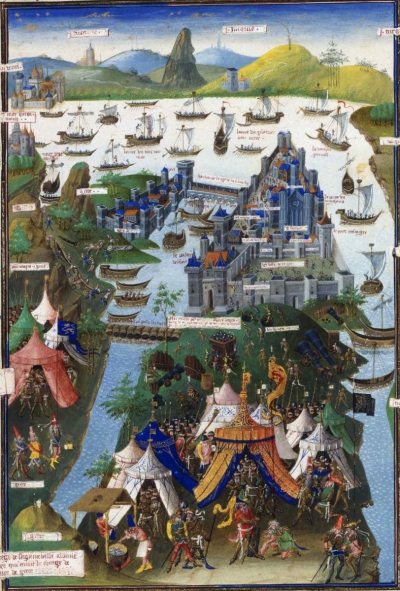Mehmed II (Ottoman Turkish: , romanized: Memed-i sn; Turkish: II. Mehmed, pronounced [icindi mehmed]; 30 March 1432 3 May 1481), commonly known as Mehmed the Conqueror (Ottoman Turkish: , romanized: Eb'l-fet, lit.'the Father of Conquest'; Turkish: Fatih Sultan Mehmed), was an Ottoman sultan who ruled from August 1444 to September 1446, and then later from February 1451 to May 1481. In Mehmed II's first reign, he defeated the crusade led by John Hunyadi after the Hungarian incursions into his country broke the conditions of the truce Peace of Szeged. When Mehmed II ascended the throne again in 1451 he strengthened the Ottoman navy and made preparations to attack Constantinople. At the age of 21, he conquered Constantinople (modern-day Istanbul) and brought an end to the Byzantine Empire.
After the conquest Mehmed claimed the title Caesar of the Roman Empire (Ottoman Turkish: , romanized: Qayser-i Rm), based on the fact that Constantinople had been the seat and capital of the surviving Eastern Roman Empire since its consecration in 330 AD by Emperor Constantine I. The claim was only recognized by the Patriarchate of Constantinople. Nonetheless, Mehmed II viewed the Ottoman state as a continuation of the Roman Empire for the remainder of his life, seeing himself as "continuing" the Empire rather than "replacing" it.
Mehmed continued his conquests in Anatolia with its reunification and in Southeast Europe as far west as Bosnia. At home he made many political and social reforms, encouraged the arts and sciences, and by the end of his reign, his rebuilding program had changed Constantinople into a thriving imperial capital. He is considered a hero in modern-day Turkey and parts of the wider Muslim world. Among other things, Istanbul's Fatih district, Fatih Sultan Mehmet Bridge and Fatih Mosque are named after him.
The Fall of Constantinople was the capture of the capital of the Byzantine Empire by the Ottoman Empire. The city fell on 29 May 1453, the culmination of a 53-day siege which had begun on 6 April 1453.
The attacking Ottoman Army, which significantly outnumbered Constantinople's defenders, was commanded by the 21-year-old Sultan Mehmed II (later called "Mehmed the Conqueror"), while the Byzantine army was led by Emperor Constantine XI Palaiologos. After conquering the city, Mehmed II made Constantinople the new Ottoman capital, replacing Adrianople.
The Fall of Constantinople marked the effective end of the Roman Empire, a state which dated to 27 BC, and had lasted nearly 1,500 years. The capture of Constantinople, a city which marked the divide between Europe and Asia Minor, also allowed the Ottomans more effectively to invade mainland Europe, eventually leading to Ottoman control of much of the Balkan peninsula.
The conquest of Constantinople and the fall of the Byzantine Empire was a watershed of the Late Middle Ages and is considered the end of the medieval period. The city's fall also stood as a turning point in military history. Since ancient times, cities and castles had depended upon ramparts and walls to repel invaders. The Walls of Constantinople, especially the Theodosian Walls, were some of the most advanced defensive systems in the world. These fortifications were overcome with the use of gunpowder, specifically in the form of large cannons and bombards, heralding a change in siege warfare.

 English
English  español
español  français
français  português
português  русский
русский  العربية
العربية  简体中文
简体中文 
